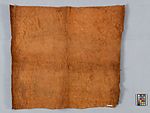Bark Cloth
About this object
History of use
The Ganda (or Baganda) wear bark cloths during ceremonies, such as coronations and healing, and rites of passages, such as marriages and funerals. Some people associate bark cloths with death and the afterlife, so bark cloths tend to be found amongst traditional healers, mediums, and witches. Historically, craftspeople of the Ngonge clan made bark cloths for both the royal family and their community members. Cloths belonging to kings and chiefs are dyed black and white to differentiate them from their subjects. In 2005 UNESCO proclaimed the bark cloth as an Intangible Cultural Heritage of Humanity, and it continues to be one of the prevalent symbols of the Ganda people today.
Cultural context
Worn as a garment by men and women in this area.
Specific techniques
Handmade by pounding and drying inner bark of a Mutuba tree harvested during wet seasons. The pounding is done with sticks until fibres are flattened and adhere together.
Physical description
Large piece of pounded bark cloth; almost square.
